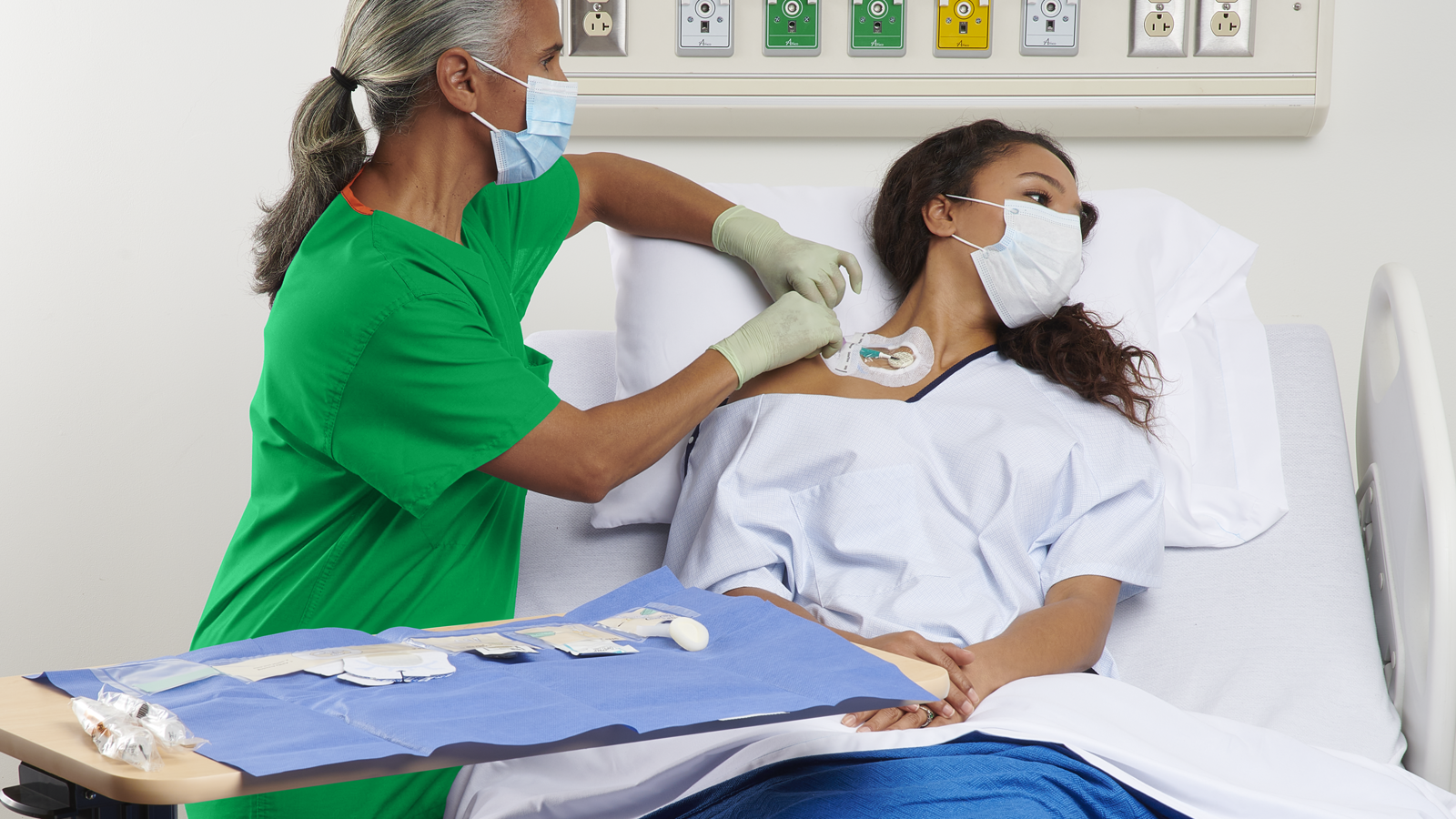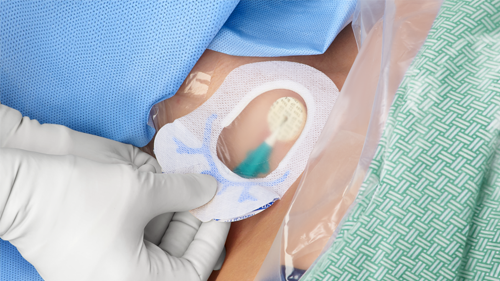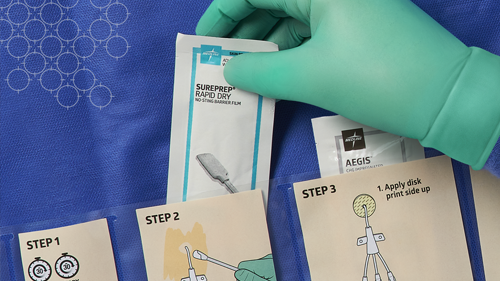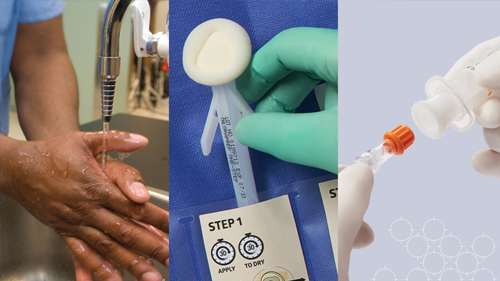Benefit of the CLABSI prevention bundle: Webinar recap
Learn how to standardize central line insertion and dressing changes.

Central line-associated bloodstream infection (CLABSI) is one of the most dangerous healthcare-associated infections (HAIs), with a patient mortality rate of 12 to 25%.1 It’s also associated with significant morbidity and costs. What can healthcare workers do to prevent CLABSIs and keep patients safe?
In a webinar titled “Benefit of the Bundle” for the Association for Vascular Access, Donna Matocha, DNP, MSN, VA-BC, Medline Manager of Clinical Resources; and Vincent Tessitore, VA-BC, Medline Clinical Resource Manager, discuss evidence-based practice components when bundling for CLABSI prevention.
“Our goal is to improve patient and clinical safety—and ultimately improve patient outcomes,” says Matocha. “We want everyone to reduce variability and look at the whole life of the line.”
The way to do that? Consider the Institute for Healthcare Improvement (IHI) central line bundle.
5 elements of the IHI bundle
Per Matocha, “IHI bundle2 elements are not separate. They work together and are monitored together for adherence.”
- Hand hygiene
- Maximal barrier precautions
Use of insertion and dressing change kits - Chlorhexidine skin antisepsis
- Optimal catheter site selection, with avoidance of using the femoral vein for central venous access in adult patients
- Daily review of line necessity, with prompt removal of unnecessary lines
“As you get started on using a bundle approach, it’s important to take human factors into consideration,” says Matocha. “Specifically, understand people’s capabilities and limitations as well as the organization culture. In addition, recognize that special skills require ongoing education.”
65 to 70% of CLABSIs
can be prevented1
It’s all in the technique
Matocha and Tessitore then describe bundle practices that promote successful central line insertion and maintenance.
Aseptic Non-Touch Technique® (ANTT)
Aseptic technique is the process of maintaining sterility during medical procedures. ANTT3 is a framework developed by the Association for Safe Aseptic Practice. When performed correctly, it ensures that you don’t touch any critical part(s) or site(s) of an invasive clinical procedure.
Hand hygiene practices
“Hands should be prepped for the day before you clean or sanitize your hands,” says Tessitore. “That means nails trimmed to one-quarter inch, clean nail beds, no nail polish, no acrylic nails and no jewelry on fingers or near hands.”
There are multiple moments of hand hygiene during line insertion, maintenance and removal.4 In addition, “Anytime hands are visibly soiled or contaminated, wash with soap and water in addition to using sanitizer,” says Tessitore.
Bundle elements are not separate. They have to work together and be monitored for compliance together.

Donna Matocha, DNP, MSN, VA-BC
Medline Manager of Clinical Resources
Maximum sterile barrier
Maximum sterile barrier precautions are defined as wearing a sterile gown, sterile gloves, and cap and using a full body drape (similar to the drapes used in the operating room) during the placement of a central line. In other words, using the right personal protective equipment.
“Eye protection also is important and should be a part of the precautions,” says Tessitore.
Skin antisepsis
Best practice entails pre-cleaning with CHG the right amount of time, using the right motion, on the right amount of area—and allowing sufficient dry time.
Be thorough; you don’t know last time patient was bathed or sheets were changed,” says Tessitore.
Site selection and daily necessity
Tessitore explains how to determine optimal site selection for the central line. He also describes how to assess if a line is still needed and when it should be removed.
When are bundles a good idea for your facility?
- Procedures that require lots of supplies
- Stressful situations such as code or trauma
- Sterile procedures
- High-risk, low-volume procedures
Hands should be prepped for the day before you clean or sanitize your hands.

Vincent Tessitore, VA-BC
Medline Clinical Resource Manager
How to develop a bundle and build a kit
Developing a bundle
- Review CLABSI and patient outcome data
- Review variability in insertion and maintenance practices
- Identify areas of low compliance
- Identify what your facility needs, from processes to products
Building a kit
- Make the experience consistent with your policy and enhanced barrier precautions
- Gather every item that is used in the procedure
- Review steps in the procedure and opportunities for contamination
- Engineer the bundle to match the procedure, promote asepsis and provide cues for compliance
“Use evidence-based practice and a collaborative structure to mitigate risk,” says Matocha.
Key takeaway
CLABSI is one of the most dangerous HAIs. Practice and product variability can lead to higher CLABSI rates. You can help mitigate risk by developing a bundle based on the IHI central line bundle for insertion and maintenance.
References:
- Centers for Disease Control and Prevention. (2011). Vital signs: central line-associated blood stream infections—United States, 2001, 2008, and 2009. Annals of Emergency Medicine, 58(5), 447-450.
- Institute for Healthcare Improvement. (2012, March). IHI How-to Guide: Prevent Central Line Associated Bloodstream Infections. How-to Guide: Prevent Central Line-Associated Bloodstream Infection | IHI – Institute for Healthcare Improvement
- The Association for Safe Aseptic Practice. (n.d.). ANTT Clinical Practice Framework. Retrieved April 1, 2022, from ANTT Practice Framework
- Centers for Disease Control and Prevention. (n.d.). Hand hygiene in healthcare settings: Healthcare providers. Retrieved April 1, 2022, from https://www.cdc.gov/handhygiene/providers/index.html




